AMONG INSECTS WITH COMPLETE METAMORPHOSIS...
EGG  LARVA
LARVA  PUPA
PUPA  ADULT
ADULT
EGG  NYMPH
NYMPH  ADULT
ADULT
Immature insects come in a rainbow of sizes, shapes, colors and configurations -- many of them nothing like caterpillars. It's important to keep in mind that in many insect species, the immature stages are more conspicuous, and impact their environment more, than their adult stage.
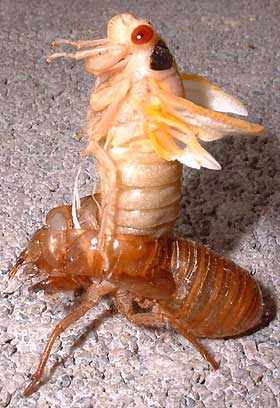
For example, nymphs of certain species of periodical cicada, like that shown at the left, may live underground for 13 or 17 years, sucking fluids from plant roots. However, when the adults emerge above ground, they live for only a few weeks, their main job being to mate and for the female to lay eggs. Then they die. In the picture, a still-developing adult cicada emerges from the exoskeleton of its nymph. Adults of some moth species with very well known and important caterpillars, don't even have functional mouthparts. They emerge from their pupa, mate, the female lays eggs, and then they die without any predator or disease killing them.
NYMPHS
Larvae usually look very different from the adults of their species. Nymphs usually look like small, wingless editions of their adult forms. On nymphs, after their first or second molt, usually small pads (the beginnings of wings) emerge from their thoraxes. Pupae look like neither larvae nor nymphs, take many forms, and usually don't move from one place during their existence.
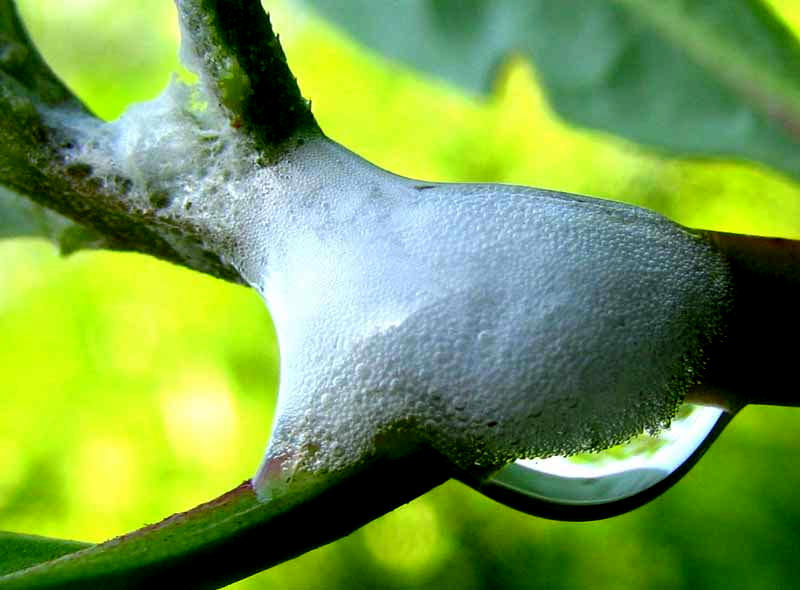 What's that at the left? It looks like someone has spit on a forked tree stem, doesn't it? Well, if you get up the nerve to wipe away some of the spit you'll find a pale little nymph quietly feeding on the leaf, constantly producing around it the spume you see, as shown in the second picture at the left.
What's that at the left? It looks like someone has spit on a forked tree stem, doesn't it? Well, if you get up the nerve to wipe away some of the spit you'll find a pale little nymph quietly feeding on the leaf, constantly producing around it the spume you see, as shown in the second picture at the left.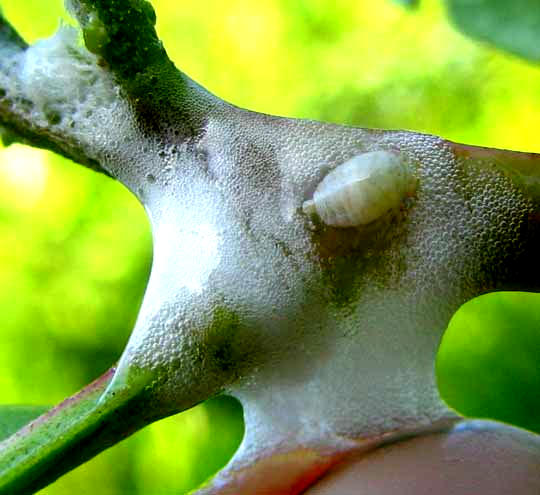 The spume hides the nymph from predators. The spume-making nymphs of this particular kind of insect are known as spittlebugs, and often they are abundant in weedy places. If you keep your eyes open you'll eventually see some.
The spume hides the nymph from predators. The spume-making nymphs of this particular kind of insect are known as spittlebugs, and often they are abundant in weedy places. If you keep your eyes open you'll eventually see some.
Spittlebugs metamorphose into cute little adult insects called froghoppers -- because they are hopping insects, and have broad heads like frogs. 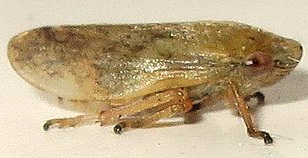 They belong to the order Hemiptera, suborder Auchenorrhyncha, along with cicadas and leafhoppers. You can see that their nymphs share the adults' general shape, but lack the adults' fully formed wings. Below, on a human's hairy arm, you can see a grasshopper nymph with functional antennae, mouthparts, and legs, but no wings, yet.
They belong to the order Hemiptera, suborder Auchenorrhyncha, along with cicadas and leafhoppers. You can see that their nymphs share the adults' general shape, but lack the adults' fully formed wings. Below, on a human's hairy arm, you can see a grasshopper nymph with functional antennae, mouthparts, and legs, but no wings, yet.
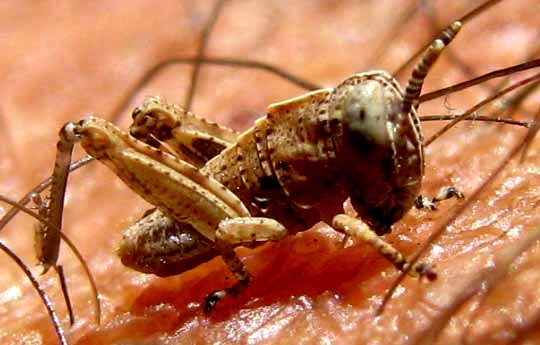
LARVAE YOU SELDOM SEE
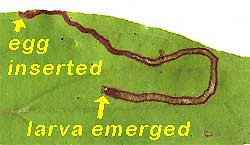 Sometimes you don't see the larval stage but you see where the larva has been. For instance, the picture at the left shows where a leaf miner has tunneled through the blade of a Roughleaf Dogwood, Cornus drummondii. The mother leaf beetle inserted an egg inside the leaf, near the margin, the egg hatched and then the wormlike larva tunneled inside the leaf.
Sometimes you don't see the larval stage but you see where the larva has been. For instance, the picture at the left shows where a leaf miner has tunneled through the blade of a Roughleaf Dogwood, Cornus drummondii. The mother leaf beetle inserted an egg inside the leaf, near the margin, the egg hatched and then the wormlike larva tunneled inside the leaf.
As the larva tunneled and ate, it grew, as might be expected. Finally you can barely see where the larva metamorphosed and exited the leaf, leaving a tiny hole. Leaf miner squiggles occur in many kinds of leaves and usually a species of leaf miner patronizes a certain species of plant leaf. Such squiggles are extremely common, so finding leaf miner tunnels could be the goal of an interesting fieldtrip. Below you see the effects of another kind of tunneling larva:
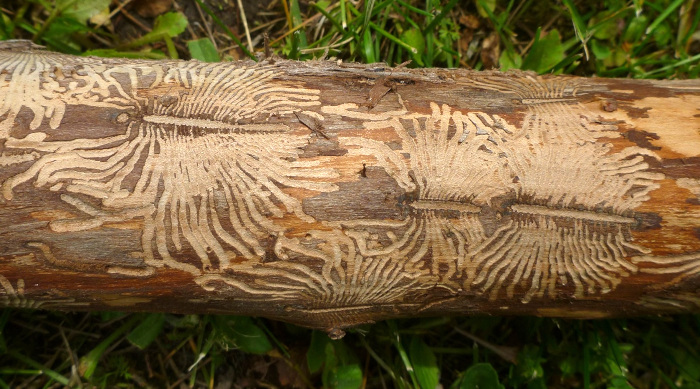
Those spidery patterns were made by the larvae of Smaller European Elm Bark Beetles, Scolytus multistriatus. They're on a dead Elm tree trunk lying on grass in Ontario, Canada. The mother beetle laid eggs in a line running parallel with the trunk's grain, between the trunk's bark and wood. When the eggs hatched, the larvae tunneled outward from the line of eggs in which they hatched, growing as they went. Then they metamorphosed into adult beetles, who left the trunk and flew away. The larvae's mines damaged the tree, but more likely the trunk in the picture was killed by Dutch Elm Disease, which emerging beetles of this species spread to other Elm trees throughout the forest. American Elms once were a very important and beautiful presence in Eastern North America, but now are rare and seldom live for long. Another Elm Bark Beetle species, the Native Elm Bark Beetle, also spreads the disease, but the eggs of that species are laid in a cut running across the trunk's grain, not parallel with it as in our picture.
OTHER KINDS OF LARVAE
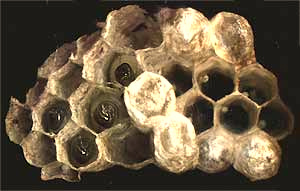 At the right you see a paper wasp. The neat thing about it is that on the nest's left side you can see the heads and plump, white bodies of wasp larvae. On the sides of some of the open cells on the right, you can see tiny, white wasp eggs attached to the cell walls. A few of the cells are capped with chewed wood-pulp. Usually when you find such a nest the cells are all capped, or else they are empty because the larvae have metamorphosed and the wasps have flown away. Maybe this nest had its cells open because it was inside a bamboo stem with only a tiny entrance hole. Below is a very different kind of larva:
At the right you see a paper wasp. The neat thing about it is that on the nest's left side you can see the heads and plump, white bodies of wasp larvae. On the sides of some of the open cells on the right, you can see tiny, white wasp eggs attached to the cell walls. A few of the cells are capped with chewed wood-pulp. Usually when you find such a nest the cells are all capped, or else they are empty because the larvae have metamorphosed and the wasps have flown away. Maybe this nest had its cells open because it was inside a bamboo stem with only a tiny entrance hole. Below is a very different kind of larva:
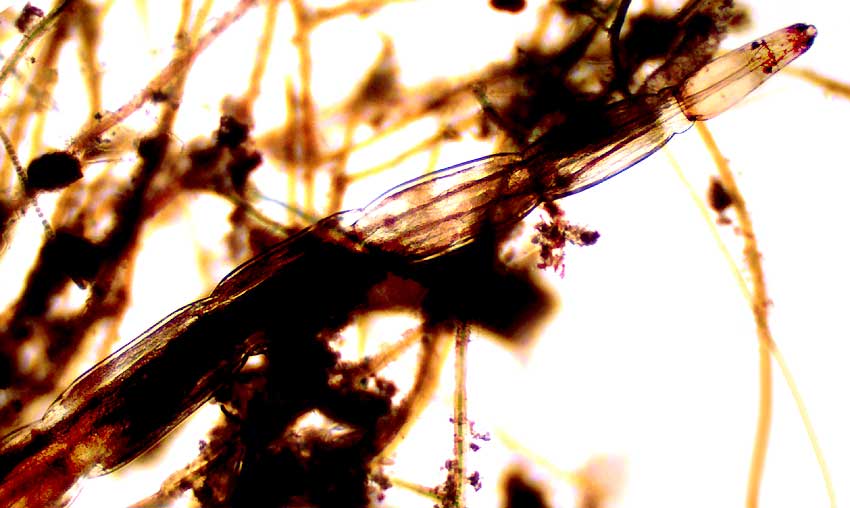
That's the larva of one of many species of biting midge, a member of the huge Fly Order, the Diptera. Not only is this snaky larva tiny -- only about 1/8th inch long (2 or 3 mm) -- but also it's aquatic. In the picture, it's swimming among filaments of algae.
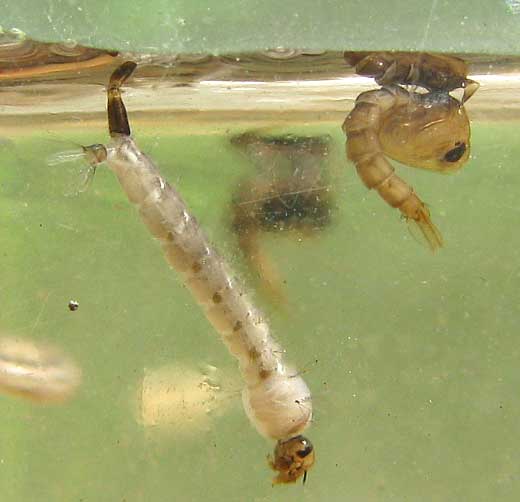 At the right, another important aquatic insect larva, that of a mosquito, is doing something interesting. The white larva on the left, often known as a wiggler or wiggle-tail, is extending its air tube, or "siphon," to the water's surface, taking in air to breathe. The brownish, comma-shaped thing at the right, sometimes called a "tumbler" because it swims so jerkily, is the mosquito's pupa. So, all insect pupae are not simply immobile resting stages! Mosquito pupae take in air through two cone-shaped breathing tubes, called "trumpets," arising from the backs of their "heads." One trumpet is visible in the picture deployed at the water's surface.
At the right, another important aquatic insect larva, that of a mosquito, is doing something interesting. The white larva on the left, often known as a wiggler or wiggle-tail, is extending its air tube, or "siphon," to the water's surface, taking in air to breathe. The brownish, comma-shaped thing at the right, sometimes called a "tumbler" because it swims so jerkily, is the mosquito's pupa. So, all insect pupae are not simply immobile resting stages! Mosquito pupae take in air through two cone-shaped breathing tubes, called "trumpets," arising from the backs of their "heads." One trumpet is visible in the picture deployed at the water's surface.
This is just a tiny introduction to the world of immature insect stages! And these are things you can see in everyday life if you keep your eyes and mind open!